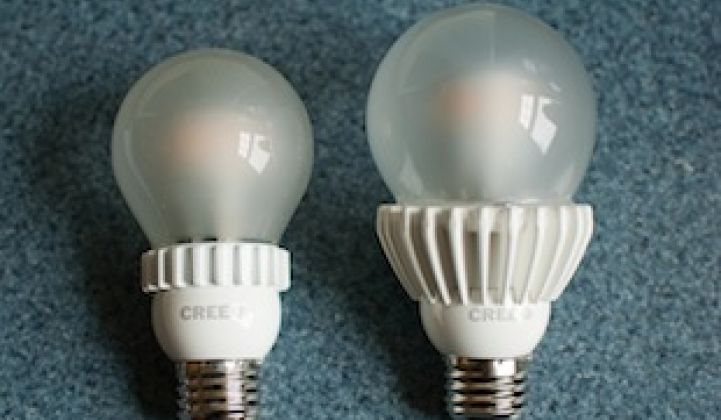One year ago, LED lighting company Cree introduced a light bulb that set a new bar in price. Today, it's introducing a 100-watt-equivalent LED bulb and lowering prices on existing products, in a move that could trigger price cuts from competitors.
On Wednesday, Home Depot will begin online sales of Cree’s latest bulb, which gives off 1600 lumens, or about the same as a 100-watt incandescent, for $19.97. Available in warmer and cooler colors, it comes in the A21 shape, which is slightly larger than a traditional bulb. It runs on 18 watts and is designed to last for many years. Home Depot is also expected to lower the price of its 60-watt-equivalent and 75-watt-equivalent LED bulbs by about 20 percent, according to a Cree representative.
The latest prices put Cree bulbs slightly below incumbent Philips, which last month lowered the price of its 75-watt-equivalent bulb to $19.97, with its 100-watt-equivalent bulb falling to $24.97. To get a sense of how quickly prices are coming down, consider that Osram’s 100-watt-equivalent LED bulbs were priced at just under $50 in November 2013.
The technology inside Cree’s 100-watt-equivalent A21 bulb is the same as that in its current products. It uses high-power LEDs placed in a vertical "tower" that's designed to give off light similar to a glowing filament. The company has been able to lower costs through a combination of manufacturing process improvements and higher volume, said Mike Watson, the vice president of product strategy at Cree.
Cree provided me with its latest bulb, and it's noticeably larger and brighter than the products it introduced last year (as pictured in the image above). A lot of the added bulk is the heat sink, which in the 60-watt-equivalent and 40-watt-equivalent bulbs is a small collar at the base of the bulb. Because the new bulb is an A21 shape, it’s also taller than traditional bulbs, so it won’t fit in all fixtures.
The color-rendering index for the bulb is in the low 80s. That’s good enough for most consumer applications, said Watson, although California has created a voluntary standard for LEDs with high-quality light.
Cree earns more than $500 million per year in lighting and has an estimated 10 percent market share in North America, according to the Carnotensis Consultancy. But LEDs still only represent about 1 percent of consumer lighting sales, according to Watson. As prices come down, he predicts that LED lighting will spread rapidly.
"I think the adoption rate will increase even faster than it already has been with the current round of price reductions, which is driving more competitors into LEDs," he said.
In the future, he expects "smart bulbs" that can be remotely controlled and save energy with motion and daylight sensors will help fuel LED growth in the consumer market.
But for now, one of the biggest challenges is confusion among consumers. Many users have had negative experiences with CFLs, another incandescent alternative, and consider bulbs a disposable, rather than a durable product that should last years. “Changing people's mindset about lighting is the ultimate competition," said Watson.



